
There’s something truly special about this sugar free lime mug cake recipe (low carb version) that words just can’t capture. Picture this: it’s like that refreshing breeze on a scorching day—totally unexpected but oh-so welcome.
Just so you know where we’re coming from, we put this recipe through the wringer, testing it more times than we can count. It was a journey, let me tell you!
There were days when our kitchen was practically a limemug cake factory, with taste tests happening round the clock. But you know what? Every single person who’s tried it has been hooked.
From the depths of our hearts, we hope you enjoy it as much as we do. This recipe was crafted with tons of love and attention to detail.
And if you’re still on the fence, here are three solid reasons why you should definitely give this lime mug cake a chance!
- 3 Motives to love this lemon mug cake
- Check out how to prepare this recipe on video
- Choosing ingredients: substitutions, types and benefits for lemon mug cake
- How to make lime mug cake in the microwave (step-by-step guide with images)
- How to prepare in advance, store, freeze and reheat this sugar free lime mug cake
- My fitness pall nutritional information
- What to serve with this microwave lime cake
- Lime mug cake recipe (printing option)
- FAQ: Frequently asked questions
3 Motives to love this lemon mug cake

- You won’t believe it, but this recipe is ready in just a minute and a half in the microwave! Yep, you heard that right.
- And here’s the kicker—it’s a sugar-free, gluten-free option that’s ideal for a guilt-free snack or dessert. How awesome is that?
- Now, let’s talk taste. The dough? Oh, it’s fluffy and sweet, with a delightful hint of lime, all thanks to natural ingredients. It’s like a little slice of heaven in every bite!
Check out how to prepare this recipe on video
Before we dive into the video showing just how quick and easy it is to whip up this fit lemon mug cake, let me give you a sneak peek of what’s waiting for you afterward:
- Types, substitutions, and ingredients for different purposes
- Detailed step-by-step recipe with pictures
- How to store, freeze, and reheat
- Macronutrients and calories
- Syrups to accompany
- Printable recipe
- FAQ
Choosing ingredients: substitutions, types and benefits for lemon mug cake
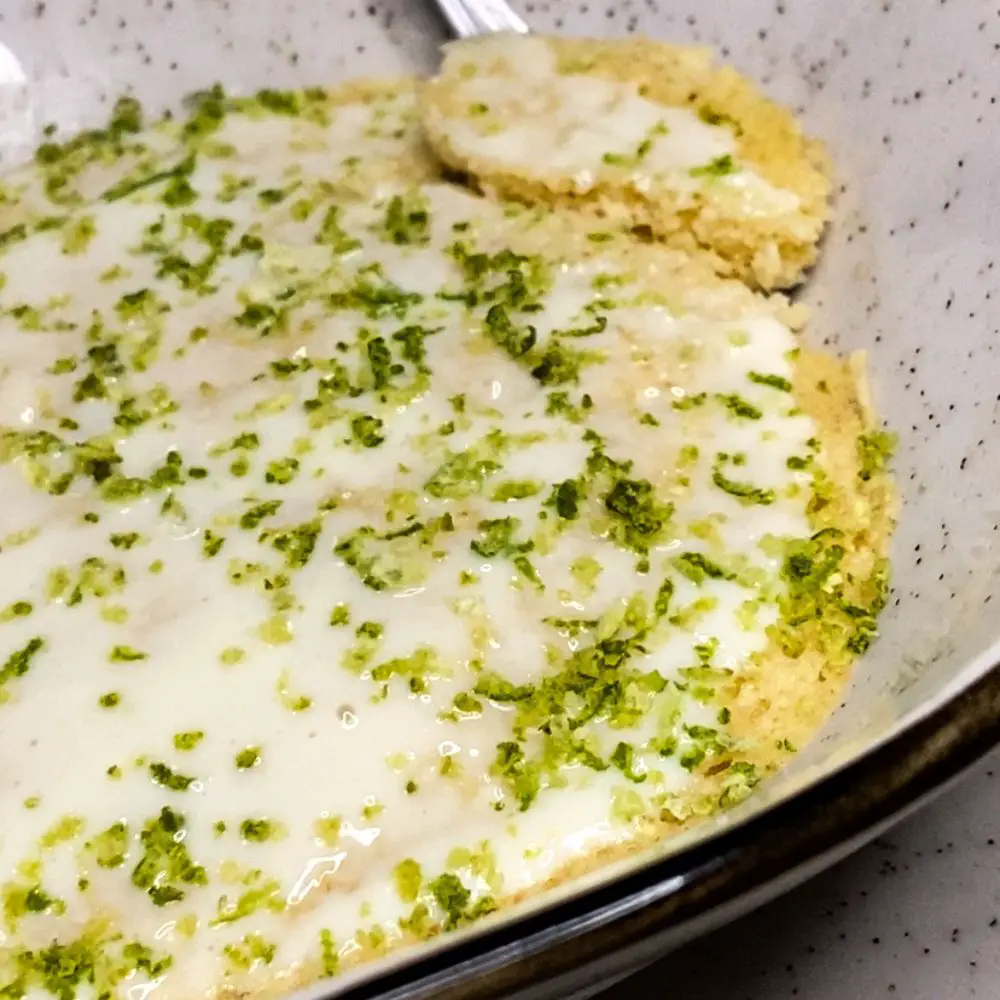
Here’s a breakdown of the key ingredients and their substitutions for our fit lemon mug cake recipe:
Egg: Acting as the foundation of our mug cake, the egg provides essential protein. While there’s no direct vegan substitute, you can opt for just the egg white to cut down on calories.
Sweetener: Here’s where you have some flexibility. Feel free to get creative and use your preferred sweetener. We found success with xylitol, but erythritol is also a great option, especially if you’re watching your calorie intake.
Coconut Flour: This flour brings a unique texture and flavor to our mug cake. While it’s not easily replaced, it’s widely available in health food stores and often at a reasonable price. We haven’t found a suitable substitute in our tests, so it’s worth seeking out.
Oatmeal: A classic choice that adds substance and fiber to our recipe. If you don’t have oatmeal on hand, almond flour is a lower-calorie alternative that works well. For those who prefer a more traditional approach, wheat flour can be used, though it’s not as nutrient-dense.
Milk + Butter: This simple combination of milk and butter is key to achieving that light, airy texture we all love. Alternatively, you can swap in heavy cream for the same luxurious feel.
The beauty of this recipe is that it’s flexible—you can use any type of milk you prefer, whether it’s dairy, lactose-free, or plant-based.
When it comes to butter, coconut oil makes for a seamless replacement, ensuring your dough stays soft and moist. While olive oil can work, it may impart a subtle aftertaste.
Baking Powder: Ah, the secret ingredient for that perfect rise! Baking powder is the unsung hero of our fit microwave lime muffin, ensuring it reaches lofty heights with ease.
How to make lime mug cake in the microwave (step-by-step guide with images)
Step 1
In a bowl, add one egg and one and a half tablespoons of sweetener and mix well (we used xylitol, but you can use any sweetener you prefer). Beat until the yolk and egg white are fully combined (to avoid an eggy taste).

Step 2
Add two tablespoons of coconut flour and two tablespoons of oat flour and mix very well.
For a fluffy result, we don’t recommend substituting the coconut flour, but the oat flour can be replaced with most flours, like almond flour, wheat flour, oat bran, etc., using the same amount.

Step 3
Next, in another container, add one teaspoon of butter and microwave until melted, about 20 seconds. Add two tablespoons of your preferred milk (we used skim milk) to the butter and mix.
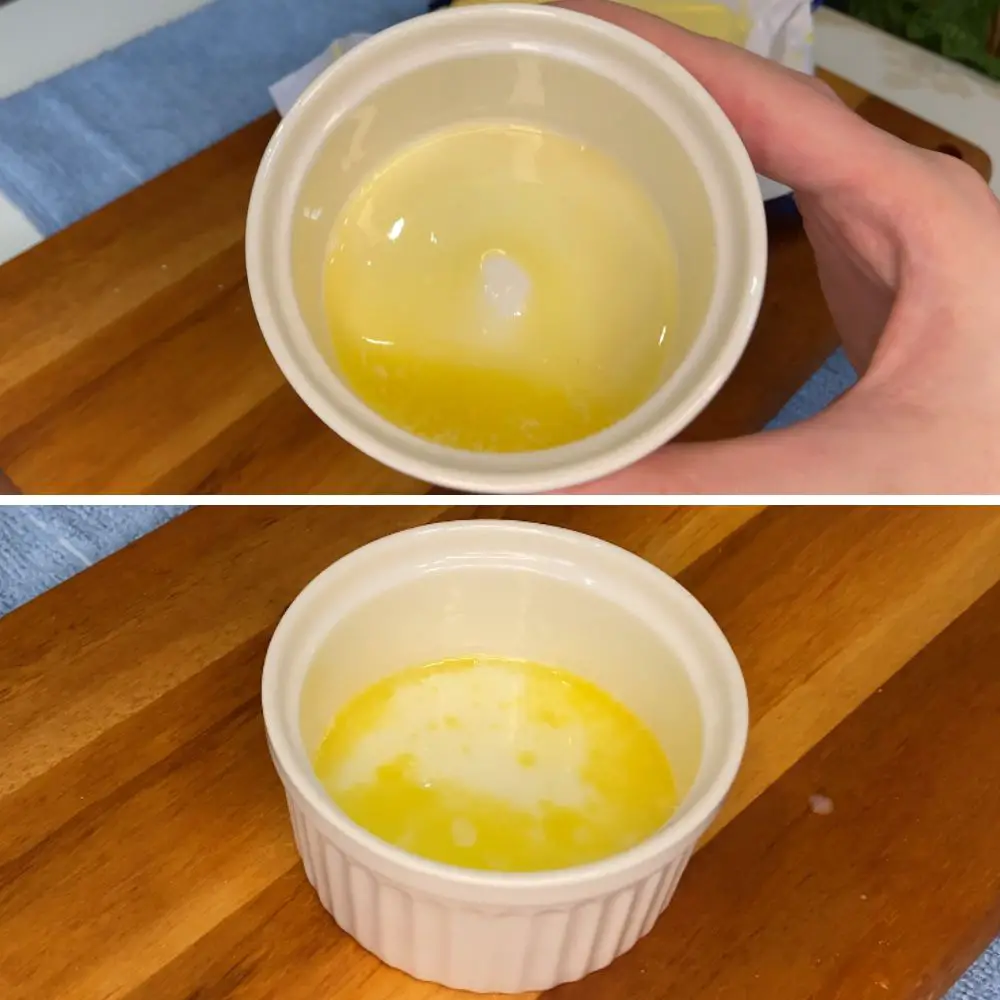
Step 4
Add the milk and butter mixture to the batter and mix.
Step 5
Add four tablespoons of lemon juice (we used the juice from one lemon) and mix.

Step 6
Add 2/3 teaspoon of baking powder and mix gently.

Step 7
This recipe makes two small dessert servings, which you can divide into two small containers before microwaving.
For a snack or breakfast, we recommend making both servings (the whole recipe). You can use a medium/large mug.
Microwave for 1 minute and 30 seconds on medium power or until a toothpick inserted comes out clean.

Step 8
Optional: If desired, finish with a lemon glaze and lemon zest. Below are some ideas you might like.

How to prepare in advance, store, freeze and reheat this sugar free lime mug cake
We keep dishing out cake recipes because, let’s face it, there’s never a bad time for cake! Not only are they scrumptious, but they’re also incredibly practical.
With our low carb lime mug cake recipe, you’ve got options for prepping ahead:
How to store lime mug cake in the fridge
Dough: Simply cover the container with plastic wrap or a lid and pop it in the fridge.
The dough can be stored like this for up to 24 hours. Just remember, if you’re using yeast, it’s best to add it when you’re ready to bake to ensure optimal rising.
Ready-Made Cake: Let your lime mug cake cool completely, then cover the container with plastic wrap or transfer it to an airtight container.
Pop it in the fridge, where it’ll stay fresh for up to 2-3 days. Just grab a slice whenever the craving strikes!
How to freeze this low carb lime mug cake
Dough: After preparing the dough, place it in an airtight container or freezer bag, ensuring to remove as much air as possible to prevent freezer burn.
Your dough can be safely stored in the freezer for up to 1 month. When you’re ready to use it, thaw it in the fridge overnight. Just remember to add the yeast right before microwaving to ensure that perfect rise.
Ready Cake: After your cake has fully cooled down, tightly wrap it first with plastic wrap and then with a layer of aluminum foil. Alternatively, you can place it in a freezer-safe airtight container. This double layering technique is essential for preventing freezer burn and ensuring the cake stays fresh.
Your ready-made cake can be stored in the freezer for up to 1 month. To enjoy, simply thaw it in the fridge overnight. If you prefer your cake warm, you can reheat it after thawing.
How to reheat sugar free lime mug cake
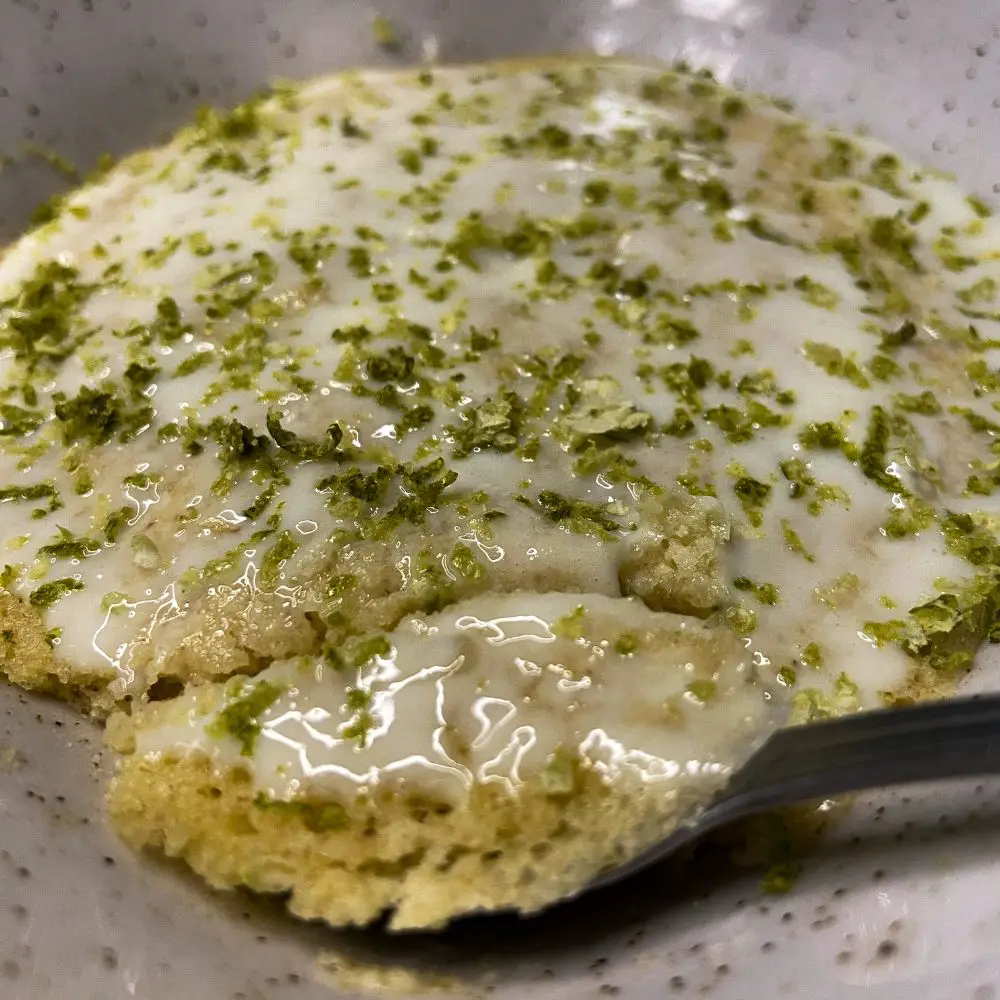
We have a soft spot for enjoying this low carb lemon mug cake straight out of the microwave or served cold. But hey, the beauty of this recipe is that you can also savor it warm if that’s more your vibe! Whether you prefer it chilled or with a cozy, comforting warmth, the choice is all yours.
Dough: If you’ve taken the dough out of the fridge, let it come to room temperature before adding the yeast. Then gently mix the yeast into the dough and follow the recipe instructions from where you left off.
Ready cake: To reheat a mug cake that has been refrigerated or defrosted, you can put it in the microwave for a few seconds until it is hot. The exact time will depend on the power of your microwave and the initial temperature of the cake.
My fitness pall nutritional information
We’ve got your back! Here’s the breakdown of the macronutrients and calories for one serving of our sugar free mug cake with lemon (yields 2 servings), excluding any syrup, sourced from MyFitnessPal:
- Calories: 169
- Total Fat: 7.1g
- Total Carbohydrates: 15.5g
- Proteins: 6.8g
What to serve with this microwave lime cake
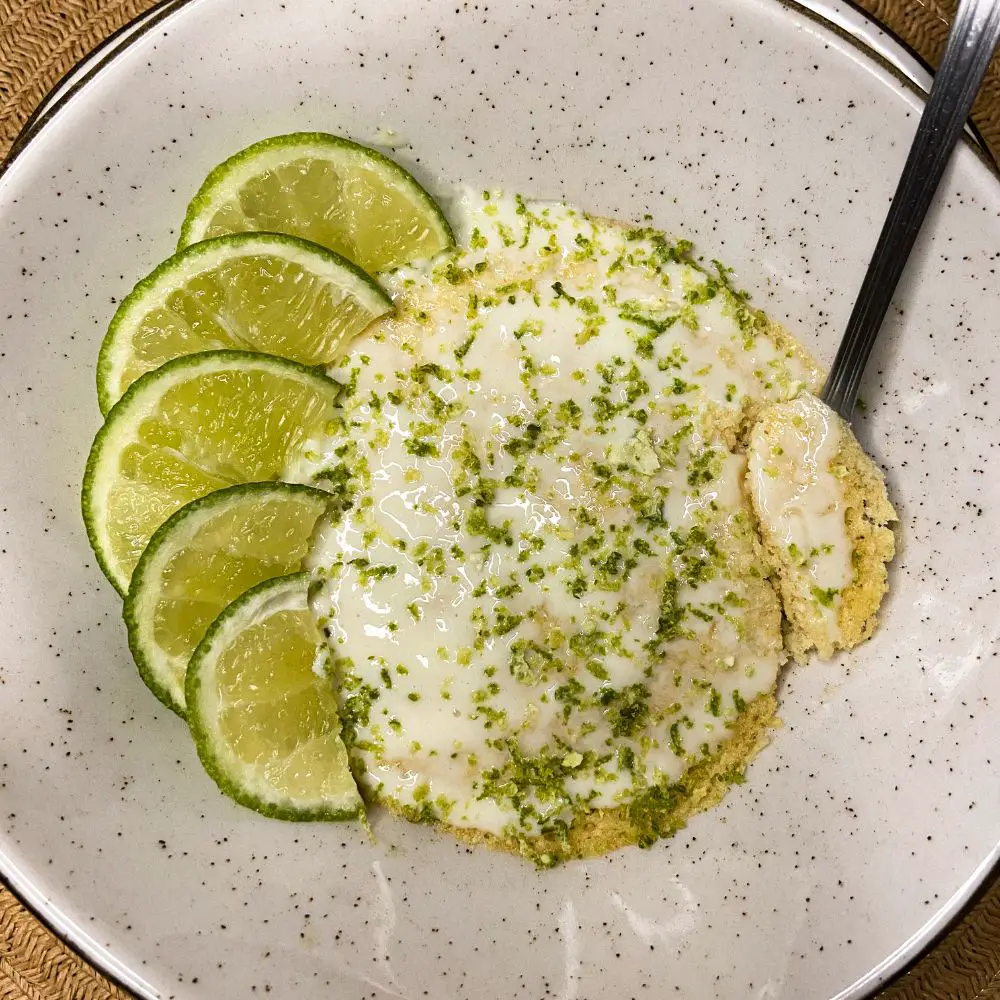
Lemon Zest:
For an extra punch of taste, aroma, and beauty, don’t overlook the power of lemon zest in your fit mug cake. Pro tip: zest the lemon before slicing it for the recipe, allowing you to utilize the entire lemon.
Syrups:
Enhance your cake experience with a delectable syrup. You can either slice your cake in half and fill it or simply drizzle the syrup on top.
For a special twist, combine a tablespoon of our 3-ingredient condensed milk recipe with a teaspoon of lime juice.
Boost the protein content by mixing a tablespoon of flavorful whey protein with a tablespoon of lime juice and a teaspoon of sweetener.
For a simpler option, melt a tablespoon of sweetener in the microwave and then stir in a teaspoon of lemon juice. Fruits:
While it may seem obvious, it’s worth mentioning! Bananas, strawberries, and even apples complement this cake perfectly.
If you prefer honey, it’s a delightful alternative to sweeten your mug cake. Simply drizzle a teaspoon of honey over the top for a natural and flavorful touch.
A Cup of Coffee:
And last but not least, when in doubt, a cup of coffee never fails to complement your mug cake experience.

Lime mug cake recipe (printing option)
EQUIPMENT
- 2 small microwaveable pots or a medium/large cup
INGREDIENTS
- 1 egg
- 1 1/2 tablespoons xylitol
- 2 tablespoons oat flour
- 2 tablespoons coconut flour
- 2 tablespoons milk +1 teaspoon melted butter or heavy cream
- 4 tablespoons lemon juice
- 2/3 teaspoon yeast
INSTRUCTIONS
- In a bowl, add the egg and beat until the yolk and white are 100% mixed, add the sweetener and mix again
- Add the flours and mix well
- Then, in another bowl, add the butter and microwave for about 20 seconds until melted, add the milk to the butter and mix.
- Add the mixture to the dumpling dough
- Add 4 tablespoons of lemon juice and mix.
- Add the yeast and mix gently
- Microwave for 1.5 minutes on medium power or until you poke a toothpick in and it comes out clean.
- Optional: if you wish, finish with a little syrup (we’ve given you some options in the What to serve with this healthy lemon mug cake section).
- RESEARCH
- simple sauteed broccoli, easy, fit, microwave, healthy, sugar free, flour free, gluten free
Mistake to avoid and a tip for an amazing recipe
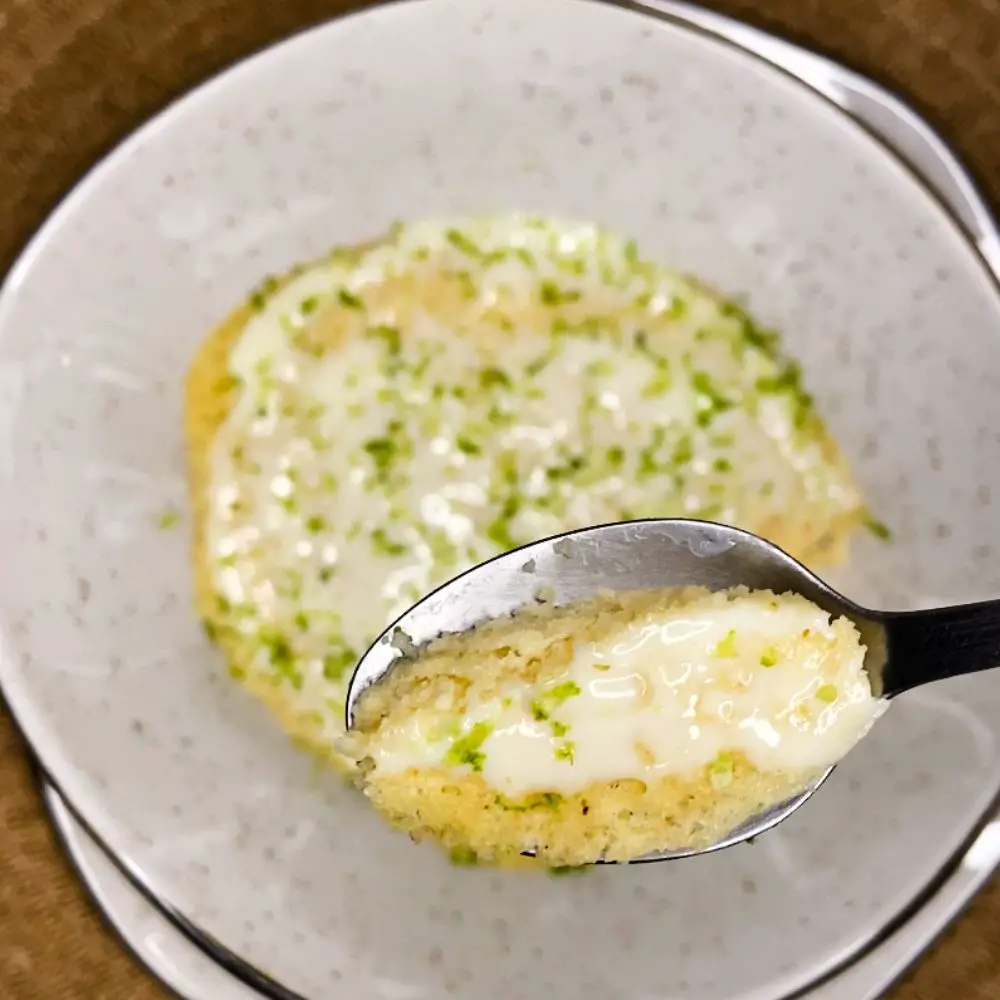
Before proceeding to the next ingredients, ensure you beat the egg thoroughly. This step is crucial, especially before incorporating the coconut flour, as it prevents any lingering egg taste from seeping into the recipe.
So, whip that egg until it’s smooth and well-combined before moving forward with the rest of the ingredients. Your taste buds will thank you!
FAQ: Frequently asked questions
If you’ve bitten into a mug cake only to find it has a rubbery texture, this could be due to overcooking or using too much egg. In the confined space of a mug, microwaves can quickly overcook the batter, leading to a tough, elastic texture. Additionally, eggs are binding agents that provide structure, but too much can result in a chewy, rubbery consistency. To avoid this, try reducing the cook time, and checking your cake periodically as it cooks.
Mug cakes are typically made from a blend of flour, sugar, leavening agents (such as baking powder), fat (like oil or butter), milk, and flavorings or add-ins like cocoa powder, chocolate chips, or vanilla extract. The beauty of mug cakes lies in their simplicity and the ease of customizing ingredients to suit your taste or dietary preferences. For a basic mug cake, combine these ingredients in a mug, mix well, and microwave for a quick and delightful dessert.
Mug cakes may turn out dense for a few reasons. One common cause is the overmixing of the batter, which can develop the gluten in the flour and lead to a heavier cake. Another factor could be an incorrect balance of ingredients, particularly the leavening agent. Too little baking powder may not provide enough lift, while too much can cause the cake to rise rapidly and then collapse, becoming dense. To ensure a lighter texture, carefully measure your ingredients and mix just until combined.
Note: this publication is not sponsored but may contain affiliate links and A.I. assistance.